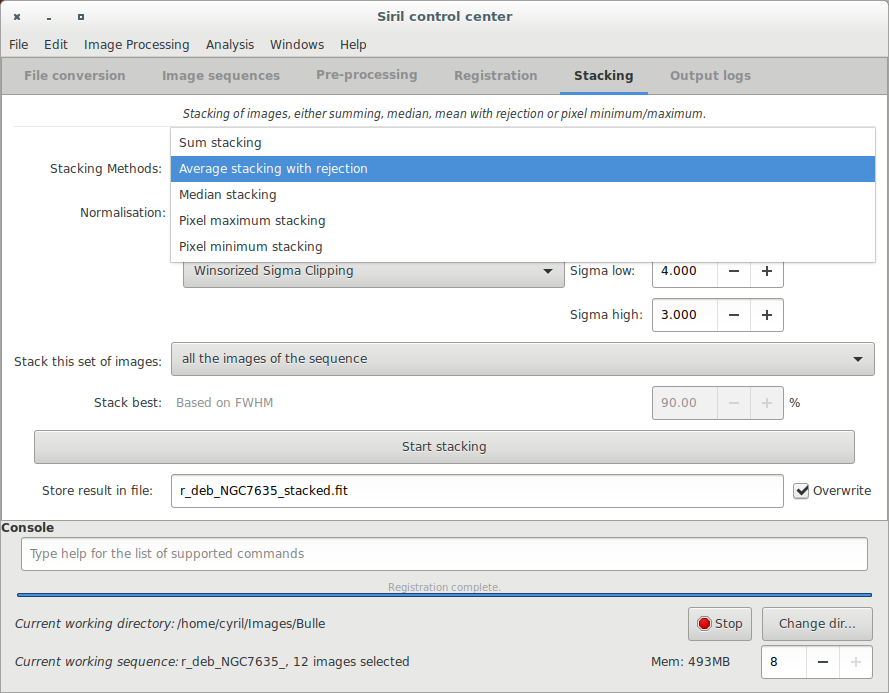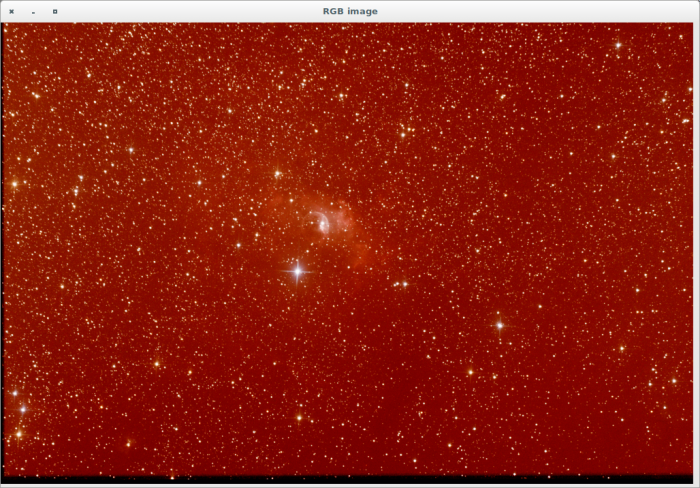Siril processing tutorial
- Convert your images in the FITS format Siril uses (image import)
- Work on a sequence of converted images
- Pre-processing images
- Registration (PSF image alignment)
- → Stacking
Stacking
The final thing to do with Siril is to stack the images. Go to the "stacking" tab, indicate if you want to stack all images, only selected images or the best images regarding the value of FWHM previously computed. Siril proposes several algorithms for stacking computation.
- Sum Stacking
This is the simplest algorithm: each pixel in the stack is summed, using 32-bit precision, and the result is normalized to 16-bit. The increase in signal-to-noise ratio (SNR) is proportional to [math]\displaystyle{ \sqrt{N} }[/math], where N is the number of images.
- Average Stacking With Rejection
- Sigma Clipping: Sigma Clipping is an iterative algorithm which will reject pixels whose distance from median will be farthest than two given values in sigma units.
- Median Sigma Clipping: Median Sigma Clipping is the same algorithm except than the rejected pixels are replaced by the median value.
- Winsorized Sigma Clipping: Winsorized Sigma Clipping is very similar to Sigma Clipping method but it uses an algorithm based on Huber's work [1] [2].
- Linear Fit Clipping: Linear FIt Clipping is an algorithm developed by Juan Conejero, main developer of PixInsight [2].
These algorithms are very efficient to remove satellite/Plane tracks.
- Median Stacking
This method is mostly used for dark/flat/offset stacking. The median value of the pixels in the stack is computed for each pixel. As this method should only be used for dark/flat/offset stacking, it does not take into account shifts computed during registration.
- Pixel Maximum Stacking
This algorithm is mainly used to construct long exposure star-trails images. Pixels of the image are replaced by pixels at the same coordinates if intensity is greater.
In the case of M8-M20 sequence, we have simply clicked on "Sum Stacking".
After that, the result is saved in the file named below the buttons, and is displayed in the grey and colour windows. You can adjust levels if you want to see it better, or use the different display mode. In our example the file is the stack result of the 80% best files, i.e., 96 over 119 files.
The images above shows you the result displayed in Siril with the Histogram Equalization tool. Note the improvement of the signal-to-noise ratio regarding the result given for one frame in the previous step (take a look to the sigma value). Now should start the process of the image with crop, background extraction (to remove gradient), and some other processes to enhance your image. To see processes available in Siril please visit this page.
Here, comparison between the same crop of calibrated single frame and stacked result.
End of the processing tutorial. Return to the main documentation page for more illustrated tutorials.




